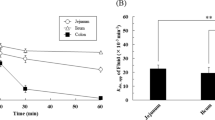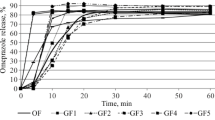ABSTRACT
Purpose
To evaluate the time-profile of intragastric fluid volume in humans after intragastric administration of drug solution.
Methods
Eight healthy volunteers were intragastrically administered 150 mL of drug solution containing atenolol (non-absorbable marker) and salicylic acid, then, aliquots of gastric fluid (ca. 2 mL) were sampled for 2 h through the catheter. Rate constants for secretion and emptying of the fluid were obtained by fitting the time-course of atenolol concentration to the simple gastric fluid transit model. Absorption of salicylic acid from the stomach was estimated by comparing its gastric concentration with that of atenolol.
Results
Kinetic analysis of atenolol concentration in the stomach indicated a rapid emptying of the fluid with an average half-life of 4.2 min. Steady-state intragastric fluid volume in 8 volunteers was estimated as 4–133 mL with an average of 42 mL. Intragastric concentration (normalized by dose) of salicylic acid was always lower than that of atenolol, showing approximately 40% of salicylic acid was absorbed from the stomach before emptying to the intestine.
Conclusions
This study provided valuable information on intragastric fluid dynamics and gastric drug absorption in humans to establish a better in vitro-in vivo correlation in oral drug absorption.





Similar content being viewed by others
REFERENCES
Van Der Meer JW, Keuning JJ, Scheijgrond HW, Heykants J, Van Cutsem J, Brugmans J. The influence of gastric acidity on the bio-availability of ketoconazole. J Antimicrob Chemother. 1980;6(4):552–4.
Lelawongs P, Barone JA, Colaizzi JL, Hsuan AT, Mechlinski W, Legendre R, Guarnieri J. Effect of food and gastric acidity on absorption of orally administered ketoconazole. Clin Pharm. 1988;7(3):228–35.
Derendorf H, VanderMaelen CP, Brickl RS, MacGregor TR, Eisert W. Dipyridamole bioavailability in subjects with reduced gastric acidity. J Clin Pharmacol. 2005;45(7):845–50.
Guidance for Industry “Waiver of In Vivo Bioavailability and Bioequivalence (BE) Studies for ImmediateRelease Solid Oral Dosage Forms Based on a Biopharmaceutics Classification System”, 2000 http://www.fda.gov/downloads/Drugs/GuidanceComplianceRegulatoryInformation/Guidances/ucm070246.pdf
Proposal to waive in vivo bioequivalence requirements for WHO Model List of Essential Medicines immediate-release, solid oral dosage forms. In: Fortieth report of the WHO Expert Committee on Specifications for Pharmaceutical Preparations. Geneva, World Health Organization. WHO Technical Report Series, No. 937, 2006, Annex 8.
EMEA Guideline on the investigation of bioequivalence 2010, London, 2010.
Amidon GL, Lennernäs H, Shah VP, Crison JR. A theoretical basis for a biopharmaceutic drug classification: The correlation of in vitro drug product dissolution and in vivo bioavailability. Pharm Res. 1995;12(3):413–20.
Yu LX, Lipka E, Crison JR, Amidon GL. Transport approaches to the biopharmaceutical design of oral drug delivery systems: prediction of intestinal absorption. Adv Drug Deliv Rev. 1996;19(3):1359–76.
Masaoka Y, Tanaka Y, Kataoka M, Sakuma S, Yamashita S. Site of drug absorption after oral administration: assessment of membrane permeability and luminal concentration of drugs in each segment of gastrointestinal tract. Eur J Pharm Sci. 2006;29(3–4):240–50.
Yamaoka K, Nakagawa T. A nonlinear least squares program based on differential equations, MULTI (RUNGE), for microcomputers. J Pharmacobiodyn. 1983;6(8):595–606.
Yu LX. An integrated model for determining causes of poor oral drug absorption. Pharm Res. 1999;16(12):1883–7.
Löbenberg R, Amidon GL. Modern bioavailability, bioequivalence and biopharmaceutics classification system. New scientific approaches to international regulatory standards. Eur J Pharm Biopharm. 2000;50(1):3–12.
Dressman JB, Reppas C. In vitro-in vivo correlations for lipophilic, poorly water-soluble drugs. Eur J Pharm Sci. 2000;11 Suppl 2:S73–80.
Sutton SC. Role of physiological intestinal water in oral absorption. AAPS J. 2009;11(2):277–85.
Schiller C, Fröhlich CP, Giessmann T, Siegmund W, Mönnikes H, Hosten N, Weitschies W. Intestinal fluid volumes and transit of dosage forms as assessed by magnetic resonance imaging. Aliment Pharmacol Ther. 2005;22(10):971–9.
Pal A, Indireshkumar K, Schwizer W, Abrahamsson B, Fried M, Brasseur JG. Gastric flow and mixing studied using computer simulation. Proc Biol Sci. 2004;271(1557):2587–94.
Ma T, Verkman AS. Aquaporin water channels in gastrointestinal physiology. J Physiol. 1999;517(Pt 2):317–26.
Shingaki T, Takashima T, Wada Y, Tanaka M, Kataoka M, Ishii A, Shigihara Y, Sugiyama Y, Yamashita S, Watanabe Y. Imaging of gastrointestinal absorption and biodistribution of an orally administered probe using positron emission tomography in humans. Clin Pharmacol Ther. 2012;91(4):653–9.
Vertzoni M, Dressman J, Butler J, Hempenstall J, Reppas C. Simulation of fasting gastric conditions and its importance for the in vivo dissolution of lipophilic compounds. Eur J Pharm Biopharm. 2005;60(3):413–7.
Serajuddin AT, Jarowski CI. Effect of diffusion layer pH and solubility on the dissolution rate of pharmaceutical acids and their sodium salts. II: Salicylic acid, theophylline, and benzoic acid. J Pharm Sci. 1985;74(2):148–54.
Author information
Authors and Affiliations
Corresponding author
Rights and permissions
About this article
Cite this article
Yamashita, S., Kataoka, M., Higashino, H. et al. Measurement of Drug Concentration in the Stomach After Intragastric Administration of Drug Solution to Healthy Volunteers: Analysis of Intragastric Fluid Dynamics and Drug Absorption. Pharm Res 30, 951–958 (2013). https://doi.org/10.1007/s11095-012-0931-1
Received:
Accepted:
Published:
Issue Date:
DOI: https://doi.org/10.1007/s11095-012-0931-1




